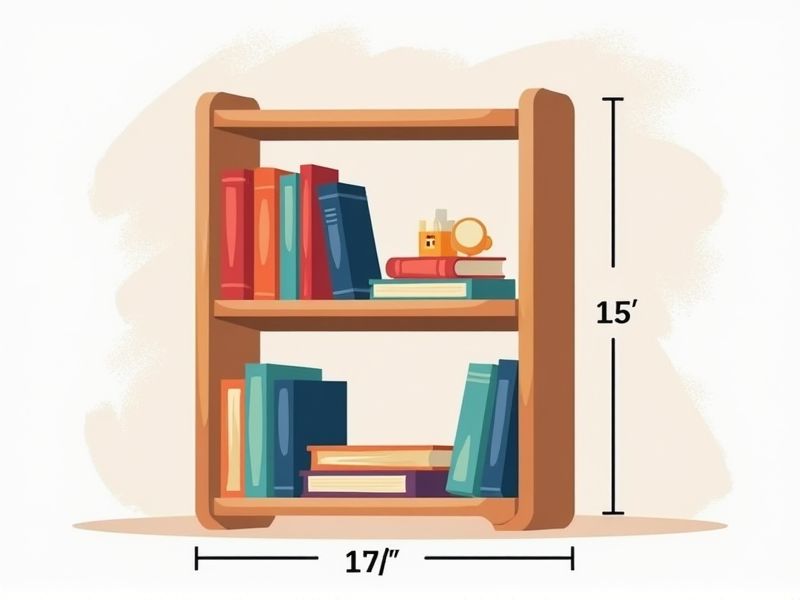
Standard bookshelf dimensions typically range from 31 to 48 inches in height, 24 to 36 inches in width, and 10 to 12 inches in depth. A popular example is a three-shelf bookcase, which often measures about 36 inches tall, 30 inches wide, and 12 inches deep. The shelves themselves are usually spaced about 10 to 12 inches apart to accommodate most standard-sized books. Knowing these measurements can help you plan your space effectively and ensure your bookshelf fits both your books and your room.
Height
The standard height for bookshelves typically ranges from 72 to 84 inches, accommodating various storage needs. Shelves are often spaced 12 to 15 inches apart, allowing for optimal organization of books and decorative items. This height not only maximizes vertical space in your room but also provides easy accessibility. For smaller spaces, consider bookshelves under 60 inches, which can still offer ample storage without feeling overwhelming.
Width
The standard bookshelf width typically measures between 24 to 36 inches, catering to various space requirements and maximizing storage efficiency. This dimension allows easy accommodation of books, decorative items, and multimedia, while ensuring stability and sturdiness. A wider bookshelf, spanning 48 inches or more, can offer enhanced capacity for larger collections or broader displays. Consider your available space and the intended use; a well-chosen width can transform your living area into an organized and aesthetically pleasing environment.
Depth
The standard depth of bookshelves typically ranges from 10 to 12 inches, which accommodates most book sizes effectively. A depth of 12 inches is ideal for holding larger hardcover books, while 10 inches suits paperbacks and smaller items. For optimal organization, it's recommended to leave at least 1 inch of clearance above the tallest book, enhancing visibility and ease of access. When customizing your bookshelf, consider adding a depth that allows for additional items, such as decorative boxes or plants, without compromising space efficiency.
Adjustable Shelves
Adjustable shelves on a bookshelf enhance versatility, allowing customization to accommodate various book sizes and other items, such as decorative objects or photos. Most adjustable shelves are set at increments of 1 to 2 inches, enabling you to optimize your space efficiently. This functionality is especially beneficial for maximizing storage in smaller areas or adapting to your changing collection over time. When you choose a bookshelf with adjustable shelves, you invest in a practical solution that evolves with your needs.
Weight Capacity
Bookshelves typically have a weight capacity ranging from 50 to 250 pounds, depending on their design and materials. For instance, a solid wood bookshelf can generally support heavier loads compared to particleboard models, which often have lower weight limits. To ensure safety and stability, evenly distribute the weight across shelves and avoid overloading any single shelf. When choosing a bookshelf, consider its weight capacity in relation to your collection, ensuring it accommodates your needs without compromising structural integrity.
Material
The standard of bookshelves primarily emphasizes the quality and type of materials used, significantly impacting durability and aesthetics. Solid wood, such as oak or maple, offers longevity and a classic appearance, while engineered wood can provide a more budget-friendly option without sacrificing style. Metal bookshelves often present a modern vibe, ideal for urban living spaces, with the added benefit of strength and stability. For your selection, consider that high-quality finishes and eco-friendly materials not only enhance visual appeal but also contribute to a sustainable environment.
Design Style
Bookshelves can significantly enhance your living space and serve as a vital design element. A minimalist bookshelf, often made from materials like metal or natural wood, can create an airy feel, highlighting clean lines that appeal to modern aesthetics. In contrast, a vintage bookshelf, characterized by intricate carvings and rich finishes, adds warmth and character to any room. When selecting a bookshelf, consider the overall style of your decor, the size of your collection, and the colors that harmonize with your space to ensure a cohesive look.
Safety Features
Safety features of a bookshelf are crucial to preventing accidents in your home or office. Look for models that include anti-tip brackets to secure the unit to the wall, significantly reducing the risk of tipping over. Additionally, shelves should be made from durable materials, such as solid wood or reinforced particle board, that can support a weight capacity of at least 50 pounds per shelf. Proper spacing of shelves, typically around 12 inches apart, allows for safe storage of books and other items, ensuring they remain stable and accessible.
Finish Quality
The quality of finish on a bookshelf significantly impacts its aesthetic appeal and durability. High-grade finishes, such as polyurethane or lacquer, can enhance wood grain visibility while providing protection against scratches and moisture, with some options offering a lifespan of up to 10 years. You can expect to see a range of finishes, from matte to glossy, which can affect the overall vibe of your living space. When selecting a bookshelf, prioritize finishes that not only suit your design preferences but also ensure longevity and resistance to wear.
Assembly Requirements
When choosing a bookshelf, it's essential to consider assembly requirements to ensure a seamless setup. Many models come with pre-drilled holes and straightforward instructions, allowing for a DIY assembly in less than an hour. Check for tools included in the package; some manufacturers provide all necessary hardware to simplify the process. Moreover, the stability of the bookshelf greatly depends on proper assembly, so ensure all components are securely fastened to support your collection of books efficiently.
